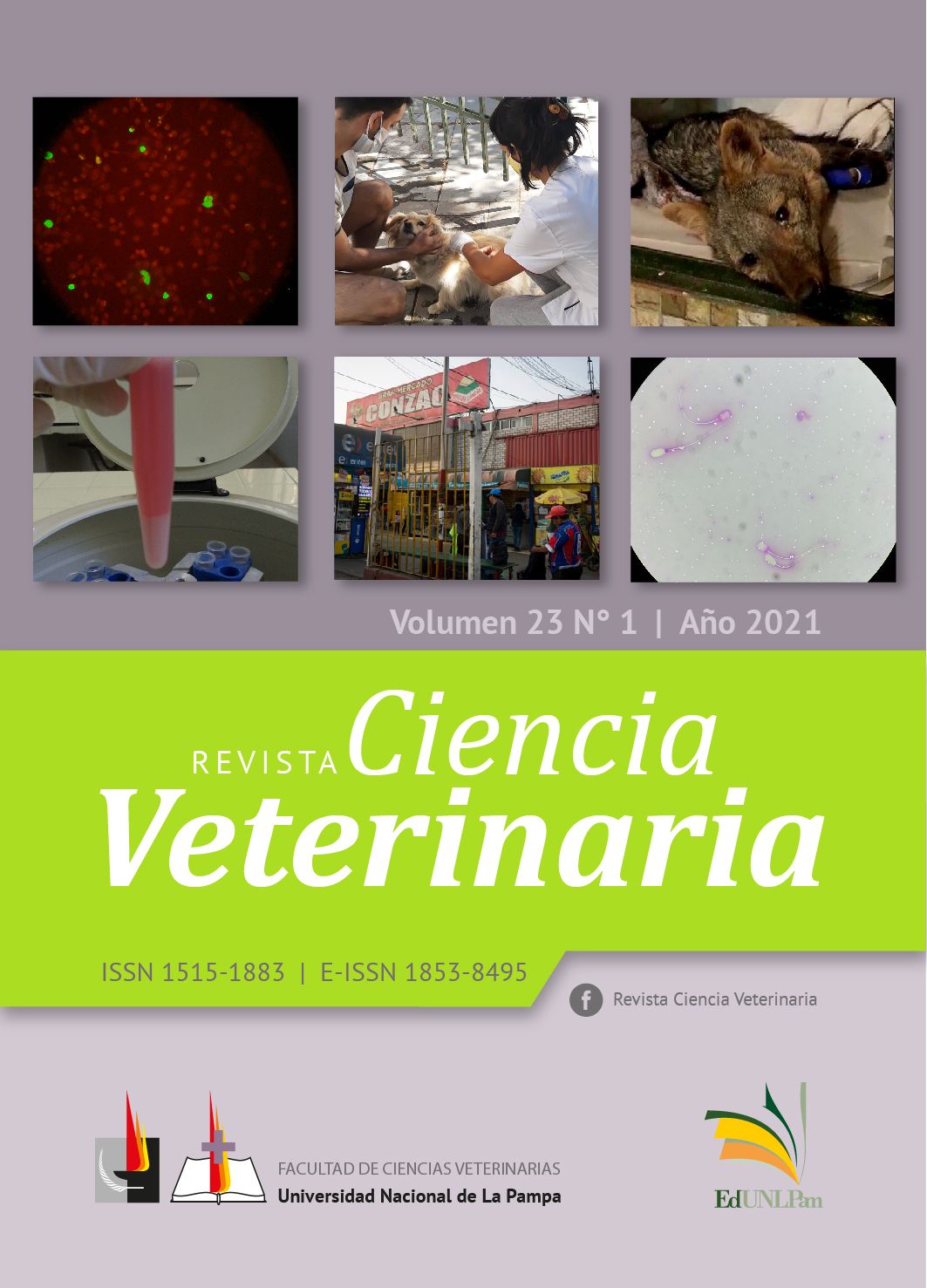Determination of the Toxic Effect of Pulmonary Extracts on Refrigerated Porcine Semen
DOI:
https://doi.org/10.19137/cienvet202123103Keywords:
porcine semen, pulmonary surfactants, cryopreservationAbstract
Synthetic surfactants have shown positive effects upon the integrity of the cell membrane of cryopreserved sperm without affecting their motility. As pulmonary extracts have surfactant substances, they are expected to produce a positive effect on the boar sperm fertility after cryopreservation. In order to have preliminary evidence regarding the absence / presence of toxicity of pulmonary extracts on semen, ejaculates from two boars, aged between 24 and 30 months, were used. Each ejaculate was divided into two groups. One of them was diluted with a middle-term commercial medium (Control group) and the other with the same medium plus the addition of: 2.5, 5 or 10% of pig pulmonary extract (Treatment group). As indicators of the treatment effect on semen quality, the live-dead ratio, the host test and the acrosome integrity were determined. Samples were evaluated after 0, 24 and 48 hours of incubation at 17 ° C and 36 ° C. The experiment was repeated in three ejaculates of each one of the boars, in order to determine interaction between the components of the preservation medium and the pulmonary extracts, and the quality of the porcine sperm. The results show that there are no differences in the parameters observed between the different evaluation moments, nor in the different extract variations, as well as no difference between individuals. It is concluded that pulmonary extracts do not present toxic effects on porcine sperm.
Downloads
References
Graham E, Crabo B. Some Factors Influencing the Freezing Of Boar Spermatozoa.
Proc. 7th. Int. Cong. Anim. Reprod., München 1972, Vol. 2, pp. 1627.
Shulman V, Johnson I. Effect Of Orvus Es Paste On Acrosome Morphology, Motility
And Fertilizing Capacity Of Frozen-Thawed Boar Semen,Pursel. J. Anim. Sci. 1978. 47:
-202.
Martin J, Klug E, Günzel A. Investigations On Centrifugation Of Stallion Semen And
Storage In Large Volume Straws. 2nd. Int. Symposium on Equine Reproduction. 1978
Davis, California, 24-28.07.
Hellemann C, Gonzalez M, Guzman A. Efecto De Yema De Huevo en Polvo, un Surfactante y Centrifugación En La Sobrevivencia De Espermatozoides Caprinos Congelados, Arch. Med. Vet. 1992. 24(2): 23-30.
Arriola J, Foote H. Glycerolation And Thawing Effects On Bull Spermatozoa Frozen
In Detergent-Treated Egg Yolk And Whole Egg Extenders. J. Dairy Sci. 1987 70:
-1670.
Hellemann M, Jara T. Efecto De Un Surfactante Sobre La Integridad De Espermatozoides Ovinos Crioconservados, Centro de Inseminación Artificial, Universidad Austral de Chile. 1997. Casilla 567, Valdivia, Chile.
Alhaider A, Watson P. Cryopreservation Of Dog Semen: The Effects Of Equex Stm Paste On Plasma Membrane Fluidity And The Control Of Intracellular Free Calcium. Department of Veterinary Basic Sciences, Royal Veterinary College, Royal College Street. 2009. London NW1 0TU, UK
Axnér E, Hermansson U, Linde-Forsberg C. The Effect Of Equex Stm Paste And Sperm
Morphology On Post-Thaw Survival Of Cat Epididymal Spermatozoa. Department of
Obstetrics and Gynaecology, Faculty of Veterinary Medicine, Swedish University of
Agricultural Sciences. 2004. P.O. Box 7039, S-75007 Uppsala, Sweden.
Marotta E. Extracción de semen en el cerdo: técnica y material. Revista de Medicina
Veterinaria 1973. 54:2534.
Downloads
Published
How to Cite
Issue
Section
License
Al momento de enviar sus contribuciones, los colaboradores deberán declarar , de manera fehaciente, que poseen el permiso del archivo o repositorio donde se obtuvieron los documentos que se anexan al trabajo, cualquiera sea su formato (manuscritos inéditos, imágenes, archivos audiovisuales, etc.), permiso que los autoriza a publicarlos y reproducirlos, liberando a la revista y sus editores de toda responsabilidad o reclamo de terceros , los autores deben adherir a la licencia Creative Commons denominada “Atribución - No Comercial CC BY-NC-SA”, mediante la cual el autor permite copiar, reproducir, distribuir, comunicar públicamente la obra y generar obras derivadas, siempre y cuando se cite y reconozca al autor original. No se permite, sin embargo, utilizar la obra con fines comerciales.








.jpg)

4.png)


7.png)



